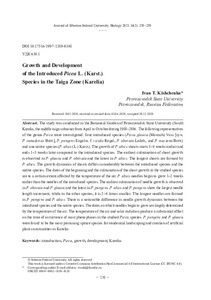Показать сокращенную информацию
Рост и развитие интродуцированных видов Picea L (Karst.) в таежной зоне (Карелия)
| Автор | Кищенко, И. Т. | ru_RU |
| Автор | Kishchenko, Ivan T. | en |
| Дата внесения | 2021-06-27T01:58:09Z | |
| Дата, когда ресурс стал доступен | 2021-06-27T01:58:09Z | |
| Дата публикации | 2021-06 | |
| URI (для ссылок/цитирований) | https://elib.sfu-kras.ru/handle/2311/141377 | |
| Аннотация | Исследования проводили в 1988–2016 гг. с апреля по октябрь в Ботаническом саду Петрозаводского государственного университета (Южная Карелия, подзона средней тайги). Объектами исследований служили представители рода Picea: четыре интродуцированных вида (Picea glauca (Moench) Voss [syn. P. canadensis Britt.], P. pungens Engelm. f. viridis Regel., P. obovata Ledeb., P. mariana Britt.) и один аборигенный (P. abies (L.) Karst.). Рост побегов у P. abies начинается на 1–4 недели раньше, а заканчивается на 1–3 недели позже, чем у интродуцентов. Ранее всего кульминация прироста побегов происходит у P. glauca и P. obovata, а позже всего – у P. abies. Наиболее длинные побеги формируются у P. abies. Динамика прироста побегов у интродуцентов значительно отличается от таковой у аборигенного вида. Начало роста побегов и кульминация их прироста у изучаемых видов в определенной мере зависит от температурного режима воздуха. Рост хвои у P. abies начинается на 1–2 недели раньше, чем у интродуцированных видов. Ранее всего кульминация ее прироста происходит у P. obovata и P. glauca, а позже всего – у P. pungens. Наибольшая величина прироста хвои характерна для P. abies и P. pungens, у других видов она в 2–4 раза меньше. Наиболее длинная хвоя формируется у P. pungens и P. abies. Динамика прироста хвои у интродуцентов существенно отличается от таковой у аборигенного вида. Начало роста хвои в значительной степени зависит от температурного режима воздуха. Существенное влияние на сроки прохождения большинства фенофаз изученных видов рода Picea оказывает температура воздуха и солнечная радиация. Наиболее перспективными для озеленения населенных пунктов и создания культурценозов в Карелии оказались P. pungens и P. glauca | ru_RU |
| Аннотация | The study was conducted in the Botanical Garden of Petrozavodsk State University (South Karelia, the middle taiga subzone) from April to October during 1988–2016. The following representatives of the genus Picea were investigated: four introduced species (Picea glauca (Moench) Voss [syn. P. canadensis Britt.], P. pungens Engelm. f. viridis Regel., P. obovata Ledeb., and P. mariana Britt.) and one native species (P. abies (L.) Karst.). The growth of P. abies shoots starts 1–4 weeks earlier and ends 1–3 weeks later compared to the introduced species. The earliest culmination of shoot growth is observed in P. glauca and P. obovata and the latest in P. abies. The longest shoots are formed by P. abies. The growth dynamics of shoots differs considerably between the introduced species and the native species. The dates of the beginning and the culmination of the shoot growth in the studied species are to a certain extent affected by the temperature of the air. P. abies needles begin to grow 1–2 weeks earlier than the needles of the introduced species. The earliest culmination of needle growth is observed in P. obovata and P. glauca and the latest in P. pungens. P. abies and P. pungens show the largest needle length increment, while in the other species, it is 2–4 times smaller. The longest needles are formed in P. pungens and P. abies. There is a noticeable difference in needle growth dynamics between the introduced species and the native species. The dates on which needles begin to grow are largely determined by the temperature of the air. The temperature of the air and solar radiation produce a substantial effect on the time of occurrence of most phenophases in the studied Picea species. P. pungens and P. glauca were found to be the most promising spruce species for residential landscaping and creation of artificial plant communities in Karelia | en |
| Язык | ru | ru_RU |
| Издатель | Сибирский федеральный университет. Siberian Federal University | en |
| Тема | интродукция | ru_RU |
| Тема | Picea | ru_RU |
| Тема | рост | ru_RU |
| Тема | развитие | ru_RU |
| Тема | Карелия | ru_RU |
| Тема | introduction | en |
| Тема | Picea | en |
| Тема | growth | en |
| Тема | development | en |
| Тема | Karelia | en |
| Название | Рост и развитие интродуцированных видов Picea L (Karst.) в таежной зоне (Карелия) | ru_RU |
| Альтернативное название | Growth and Development of the Introduced Picea L. (Karst.) Species in the Taiga Zone (Karelia) | en |
| Тип | Journal Article | ru_RU |
| Контакты автора | Кищенко, И. Т.: Петрозаводский государственный университет Российская Федерация, Петрозаводск | ru_RU |
| Контакты автора | Kishchenko, Ivan T.: Petrozavodsk State University Petrozavodsk, Russian Federation; ivanki@karelia.ru; ORCID: 0000–0002–1039–1020 | en |
| Страницы | 238–258 | ru_RU |
| DOI | 10.17516/1997-1389-0348 | |
| Журнал | Журнал Сибирского федерального университета.Биология. Journal of Siberian Federal University.Biology, 2021 14 (2) | en |

